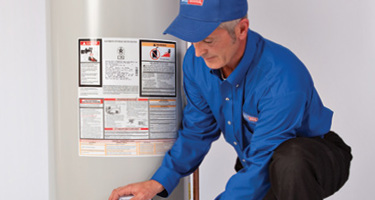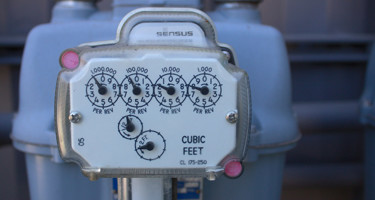
If you've noticed a musty smell near your water heater, damp drywall near your toilet, or mildew in your cabinets, you may have a plumbing leak. How you handle it depends on where this pesky leak is located.
Stopping and fixing a leaky pipe can prevent serious damage to your home. You can take some simple steps to temporarily fix a leaking pipe, and there are different set of actions you should take to rid yourself of the leak forever. In this guide, we’ll cover both solutions and let you know when it’s best to just throw some towels on the floor and call in a professional plumber near you.
The Temporary Solution: How to Stop a Plumbing Leak
Once you discover a leak, stopping it should be your first priority. Control a leak with the following steps prevents further water damage, the waste of more money to your utility bills, and can make replacing the pipe in distress a much simpler process.
Step #1: Shut off the water valve to prevent any more water flow to the leak that has been identified. If the leak is at a toilet, water heater, or sink, a valve will be present. If the leak is occurring elsewhere and no valve is visible, it would be best to go to your main water valve for the entire house and shut it off. The valve is typically located within 3 to 5 feet of where the water main enters the home.
Step #2: Remove any remaining water within the leaky pipe. In order to do this, you’ll need to turn on any faucets connected to the leaky pipe or use an air compressor to force the water out manually. Depending on the type of pipe and where the leak is, you could use gravity to help push water out too.
Step #3: Dry off any remaining condensation and water by wiping the pipe dry with a towel or cloth. You’ll want to let the pipe air dry before you address the leaking area.
Step #4: Now it’s time to seal the leak. There are a couple of ways to go about this. First, and maybe this was something your grandfather once did, but find a pencil and break the lead tip inside the leak to plug the leak up. Then find some epoxy and cover the using a putty knife. A more modern approach is to use a strong epoxy and apply it to the leaking area.
Step #5: Once the leak is stopped and the epoxy has dried, the leak should then be covered externally. Depending on what you have around the home, find some rubber or gardening hose and cut roughly 2” longer than the leak itself. If you don’t have any supplies to use at this point, with the epoxy dried this would be a good time to run out to a hardware store and get what you need. Wrap the rubber or hose around the pipe where the leak is and hold it in place. A metal hose clamps tightened to hold it in place will work great. Allow this to set for one hour.
Step #6: Apply waterproof tape around the entire area. You’re basically going to turn your pipe into a mummy. Make sure the leaking area and the rubber/hose itself is dry and then apply several layers of wrapping around the leaking area.
Step #7: Time to check your work. Turn on your valves again, and turn the water on. Let the water run for minutes and check to make sure no leak is present.
The Permanent Solution: Fixing the Plumbing Leak
Stopping a leak the DIY way we explained above does not guarantee a permanent fix to your water leakage problem. Typically when one leak is fixed, other leaks spring up. This happens in other places along the same pipe because, whether the homeowner wants to hear it or not, the whole section of pipe needs replaced due to corrosion.
We urge all homeowners to request plumbing service from us at ARS®/Rescue Rooter® once you’ve temporarily solved your leak, so our professional local plumbers can handle the task of pipe replacement. If you feel up to the challenge and want to replace the pipe yourself, these are the steps to take.
Step #1: Collect the necessary supplies you’ll need. Your shopping list should include replacement piping, emery cloth, silver solder, solder flux, a fitting brush, and a torch. Make sure you properly measure the length of pipe you will need to replace.
Step #2: Shut off the water valve to prevent any more water flow to the leak that has been identified.
Step #3: Remove any remaining water within the leaky pipe. In order to do this, you’ll need to turn on any faucets connected to the leaky pipe or use an air compressor to force the water out manually.
Step #4: Remove the damaged section of the pipe. You can do this using a hacksaw or a pipe cutter.
Step #5: Polish the existing and replacement pipes using the emery cloth and fitting brush. Remember to do this both to the outside and inside of both pipes.
Step #6: Apply a light coating of soldering flux to each side of the piping you are going to solder.
Step #7: Solder the new pipe into place. Allow the sections of piping to naturally cool.
Step #8: Turn on the water back on and check to make sure no leak is present after your repairs.
What to Do If Your Plumbing Leak is Inaccessible
Leaks behind your drywall, in your ceiling, or under your floor are best handled by professional plumbers. The sooner you call one, the better! Left unaddressed, leaky pipes can cause:
- Mold and mildew growth, which affects your indoor air quality
- Wood rot, which can ruin cabinetry and threaten the integrity of your floor and wall supports
- Paint, drywall and wallpaper damage
- Carpet or hard-surface flooring damage
What If I Have a Leaky Faucet or Showerhead?
Just because the water is dripping into a drain or basin, don't assume it's nothing to worry about. Over time, a leaky faucet can waste hundreds of gallons of water, cause your drain to rust and encourage mildew and mold growth.
If you've spotted a leak or suspect one you can't find, call the national plumbing experts at ARS®/Rescue Rooter® right away. We offer 7-day emergency plumbing service. This means that we are available to take your call anytime.






